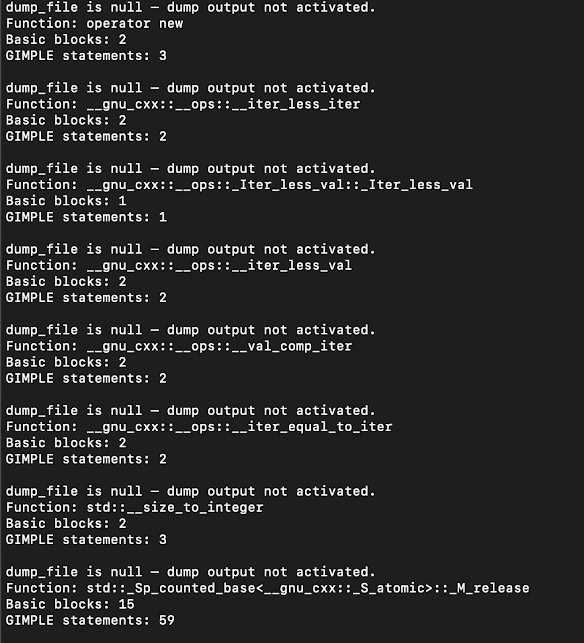Lab 4 - GCC Build Lab (Part 1)
Introduction
This lab focuses on learning how to build the GCC (GNU Compiler Collection) from source code. GCC is a widely used compiler that supports multiple programming languages, including C and C++. Since GCC is a large and complex software project, understanding its build process is essential.
By completing this lab, we will:
• Learn how to obtain, configure, and compile GCC.
• Use common build tools like make, autotools, and configure.
• Gain experience working with large open-source projects.
• Compare build performance on different architectures (x86_64 and AArch64).
For this lab, we will perform the experiment on two SPO600 servers:
1. x86-001 (x86_64 architecture)
2. aarch64-002 (AArch64 architecture)
For now, I will begin with x86-001 and document the process.
Step 1: Downloading the GCC Source Code
The first step is to obtain the latest GCC development version. The recommended way is to clone the official GCC repository using Git.
mkdir -p ~/git && cd ~/git
git clone https://gcc.gnu.org/git/gcc.git
• mkdir -p ~/git && cd ~/git → Creates a directory named git and moves into it.
• git clone https://gcc.gnu.org/git/gcc.git → Clones the entire GCC repository.
• The cloning process takes time because GCC has a long history and a large number of commits.
Step 2: Checking the Latest Commit
Once cloning is complete, we check the latest commit information. This helps verify that we have successfully obtained the latest development version.
cd ~/git/gcc
git log -1
• git log -1 → Shows details of the most recent commit like this.
commit 67e824c2497176980cb0c5d14bc730fa4ce2e1ad (HEAD -> master, origin/trunk, origin/master, origin/HEAD)
Author: Jeff Law <jlaw@ventanamicro.com>
Date: Sun Mar 2 12:08:34 2025 -0700
[RISC-V][PR target/118934] Fix ICE in RISC-V long branch support
I'm not sure if I goof'd this or if I merely upstreamed someone else's goof.
Either way the long branch code isn't working correctly.
We were using 'n' as the output modifier to negate the condition. But 'n' has
a special meaning elsewhere, so when presented with a condition rather than
what was expected, boom, the compiler ICE'd.
Thankfully there's only a few places where we were using %n which I turned into
%r.
The BZ entry includes a good testcase, it just takes a long time to compile as
it's trying to create the out-of-range scenario. I'm not including the
testcase due to how long it takes, but I did test it locally to ensure it's
working properly now.
I'm sure that with a little bit of work I could create at testcase that worked
before and fails with the trunk (by taking advantage of the fuzzyness in length
computations). So I'm going to consider this a regression.
Will push to the trunk after pre-commit testing does its thing.
PR target/118934
gcc/
* config/riscv/corev.md (cv_branch): Adjust output template.
(branch): Likewise.
* config/riscv/riscv.md (branch): Likewise.
* config/riscv/riscv.cc (riscv_asm_output_opcode): Handle 'r' rather
than 'n'.
~
(END)
Step 3: Creating a Build Directory
To avoid modifying the original source code, it is recommended to create a separate build directory.
mkdir ~/gcc-build-001
cd ~/gcc-build-001
• mkdir ~/gcc-build-001 → Creates a new directory where we will compile GCC.
• cd ~/gcc-build-001 → Moves into the build directory.
Step 4: Configuring the GCC Build
Before building GCC, we need to set up the environment by running the configure script.
~/git/gcc/configure --prefix=$HOME/gcc-test-001
• ~/git/gcc/configure → Runs the configuration script from the GCC source directory.
• --prefix=$HOME/gcc-test-001 → Specifies where GCC should be installed after compilation.
• If any missing dependencies are reported, they need to be installed before proceeding.
• Running ls -l ~/gcc-build-001/Makefile should confirm that a Makefile was generated.
Step 5: Building GCC
Now that everything is set up, we can start the build process using make.
cd ~/gcc-build-001
time make -j 24 |& tee build.log
• make -j 24 → Starts the build process with 24 parallel jobs (for faster compilation).
• time → Measures how long the build takes.
• tee build.log → Saves both the output and errors to build.log.
• The build can take a long time (possibly over an hour).
• Using screen or tmux allows disconnecting and reconnecting while the build runs.
• If any errors occur, checking build.log will help with debugging.






Comments
Post a Comment